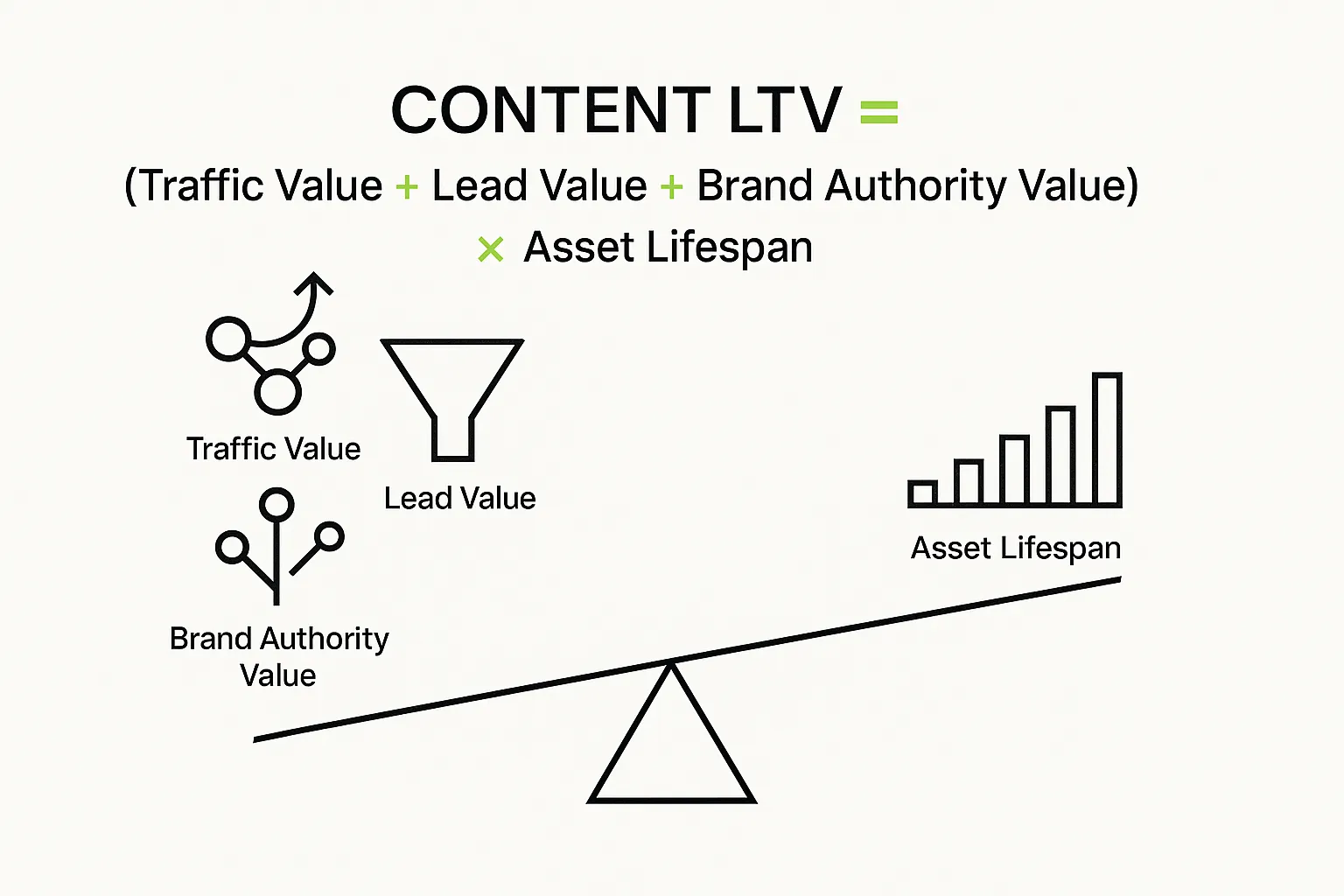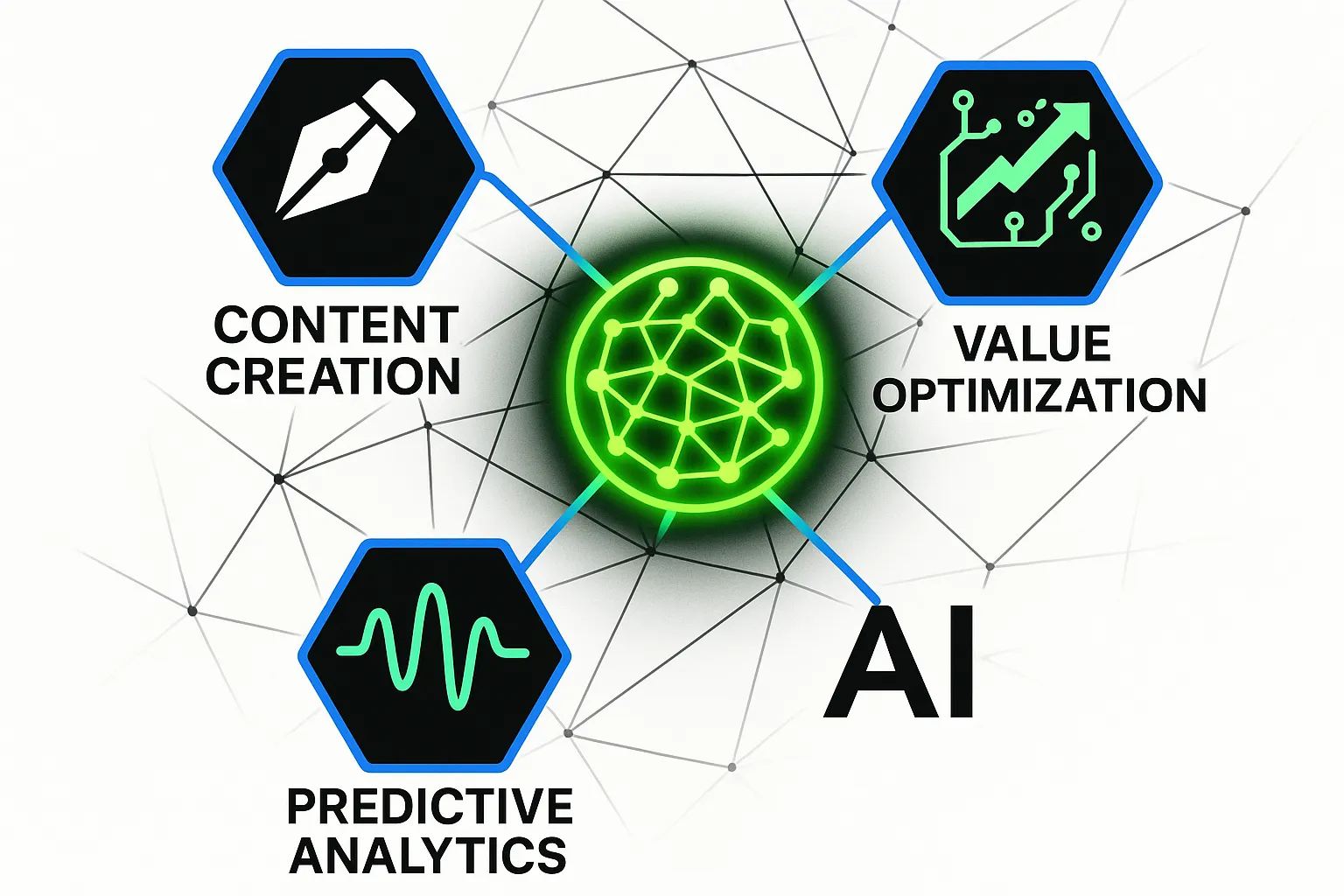The Enduring Engine How to Calculate the Long-Term Value of Your AI-Optimized Content
AI Summary
The Enduring Engine How to Calculate the Long-Term Value of Your AI-Optimized Content explains how marketers can evaluate the sustained financial and brand benefits of AI-driven content strategies beyond short-term metrics.
- Who: Marketing professionals and content strategists seeking to justify AI content investments
- What: Framework for calculating Content Lifetime Value by combining traffic, lead generation, and brand authority
- When: During quarterly reviews or planning cycles to forecast long-term ROI
- Where: Digital marketing and brand authority contexts leveraging AI for content optimization
- Why: To transform content from a cost center into a valuable, revenue-generating brand asset with measurable impact
Imagine this: You’re in a quarterly review, and your CFO turns to you. "This AI content initiative is a significant investment," she says, looking over a spreadsheet. "I see the traffic spikes, but what’s the projected three-year ROI? How is this building a defensible brand asset?"
Silence.
For many marketers, this question is a showstopper. We’re great at tracking clicks, keyword rankings, and time on page. But when it comes to connecting our content efforts to long-term financial value and sustained brand authority, the line gets blurry. We know our work has an enduring impact, but we struggle to prove it with numbers.
The rise of AI in content creation has made this challenge more urgent. AI allows us to create strategic content at a scale never before possible, but it also demands a more sophisticated way to measure its true worth. It’s no longer enough to measure the output; we must measure the asset we are building.
This guide will give you the framework to answer your CFO with confidence. We’ll move beyond short-term metrics and show you how to calculate the long-term value (LTV) of your AI-optimized content, transforming your content strategy from a cost center into a predictable, revenue-generating engine.
Foundation: Beyond Clicks and Keywords
For years, we’ve measured content success with a short-term lens. Did the blog post rank this month? How many leads did it generate this week? While useful, these metrics are like tracking daily stock prices instead of the company's fundamental value. They miss the bigger picture.
AI-optimized content, when done right, isn’t a disposable campaign asset; it’s a long-term brand asset. Like a piece of prime real estate, it appreciates over time. It continuously attracts organic traffic, builds audience trust, and strengthens your brand's authority in the market, long after you hit "publish."
To measure this, we need to adopt a new mindset and a new model: Content Asset LTV. This model reframes content as an investment and provides a formula for calculating its cumulative value over its entire effective lifespan.

This shift requires us to look at a blend of financial, engagement, and brand metrics to see the complete picture of our content's performance and enduring impact.
Building: The Framework for Calculating Content LTV
Calculating Content LTV might sound complex, but it breaks down into a logical, step-by-step process. Instead of getting lost in a sea of data, this framework helps you focus on the metrics that truly define long-term value.

Here’s how you can build your own Content LTV calculation.
Step 1: Identify the Three Core Value Components
Your content’s total value comes from three primary sources. Your goal is to assign a monthly dollar value to each.
- Organic Traffic Value: What would you have to pay for the same traffic via paid ads? This is the most direct financial contribution of your content.
- How to Calculate:
(Monthly Organic Clicks) x (Average Cost-Per-Click for target keywords)
- How to Calculate:
- Lead Generation Value: How much revenue do the leads generated from your content represent?
- How to Calculate:
(Monthly Leads from Content) x (Lead-to-Customer Rate) x (Average Customer LTV)
- How to Calculate:
- Brand Authority Value: This is the most overlooked but crucial component. It measures the "trust equity" your content builds. How much more are people searching for your brand by name?
- How to Calculate: This is more nuanced, but a great starting point is tracking the growth in branded search volume.
(Increase in Monthly Branded Searches) x (Avg. CPC of branded terms)
- How to Calculate: This is more nuanced, but a great starting point is tracking the growth in branded search volume.
Step 2: Define the Asset Lifespan
How long will this piece of content remain relevant and continue to generate value? For an evergreen pillar post, this could be 24, 36, or even 48 months. For a timely trend analysis, it might be shorter. Be realistic and base this on the topic's durability.
Step 3: Put It All Together with the Content LTV Formula
Now, combine the components into a single, powerful formula:
Content LTV = (Avg. Monthly Organic Traffic Value + Avg. Monthly Lead Value + Avg. Monthly Brand Authority Value) x Asset Lifespan (in months)
A Quick Example in Action
Let's say you create a comprehensive guide using an AI-assisted strategy.
- Monthly Organic Traffic Value: 1,000 clicks/mo at an avg. CPC of $3.00 = $3,000/mo
- Monthly Lead Value: 20 leads/mo, with a 10% close rate and $5,000 customer LTV = (20 _ 0.10 _ 5000) = $10,000. Spread over a year, that's roughly $833/mo
- Monthly Brand Authority Value: You see a lift of 150 branded searches/mo at an avg. CPC of $1.00 = $150/mo
- Asset Lifespan: You estimate it will be relevant for 24 months.
Calculation:( $3,000 + $833 + $150 ) x 24 = $95,592
Suddenly, that single piece of content isn't just a blog post; it's a strategic asset worth nearly $100,000 to the business over two years. Now that’s a number you can take to your CFO.
Mastery: Using AI to Predict and Maximize LTV
Here’s where the strategy becomes truly transformative. AI isn’t just a tool for creating content; it’s a tool for predicting and enhancing its long-term value before you even write a single word.
Think of AI as having two distinct but connected roles: The Architect and The Oracle.

- AI as the Architect: This is what most people are familiar with. AI helps you analyze competitor weaknesses, map strategic content opportunities, and structure articles that are perfectly aligned with search intent and user needs. This builds a strong foundation for high performance.
- AI as the Oracle: This is the next level. Advanced AI models can analyze vast datasets to predict the potential LTV of a content topic. By analyzing search volume trends, CPC data, competitive density, and conversion potential, AI can help you prioritize the content initiatives that will deliver the highest long-term return, ensuring your efforts are always focused on maximum impact.
By leveraging AI for both creation and prediction, you move from reactive content production to a proactive, value-driven content investment strategy.
Frequently Asked Questions (FAQ)
What is an AI content strategy?
An AI content strategy uses artificial intelligence to inform and execute every stage of the content lifecycle. It goes beyond just writing. It involves using AI for market research, identifying strategic content gaps, optimizing for search engines and user intent, and even analyzing performance data to refine future efforts. The goal is to create better, more strategic content at scale.
How is AI-optimized content different from traditional content?
The key difference is the strategic foundation. Traditional content often relies on a writer's intuition and basic keyword research. AI-optimized content is built on a deep analysis of data—what your audience is asking, what your competitors are missing, and what formats perform best. AI enhances human expertise, allowing creators to focus on insight and creativity while the AI handles the heavy lifting of data analysis and structural optimization.
Is AI content low-quality or penalized by Google?
This is a common misconception, often fueled by the current AI hype. Google’s focus is on the quality and helpfulness of the content, not how it was produced. Low-quality, unedited AI-generated text will perform poorly, just like any other low-quality content. However, when AI is used as a tool to assist human experts in creating well-researched, insightful, and helpful content, it performs exceptionally well. The value comes from using AI to enhance expertise, not replace it.
What are the first steps to start measuring Content LTV?
- Start with Traffic Value: It's the easiest component to calculate. Set up a simple spreadsheet to track your key content pieces' monthly organic traffic and the average CPC for their primary keywords.
- Establish Conversion Tracking: Ensure you can track which pieces of content are generating leads or sign-ups.
- Track Branded Search: Use a tool like Google Search Console to monitor the volume of searches for your brand name over time. Look for correlations between your content publishing schedule and lifts in branded search.
From Content Creator to Value Architect
Shifting your focus from short-term metrics to long-term value is more than just a new reporting method; it’s a fundamental change in how you approach your role. It elevates you from a content creator to a strategic business partner—a value architect who builds enduring brand assets that drive predictable growth.
By embracing the Content LTV framework, you can finally connect your hard work directly to the bottom line, answer the tough questions with data-backed confidence, and prove that a great content strategy isn't an expense—it's one of the best investments a business can make. The evolving landscape of marketing metrics in the AI era requires this level of financial sophistication, and now you have the tools to lead the charge.


